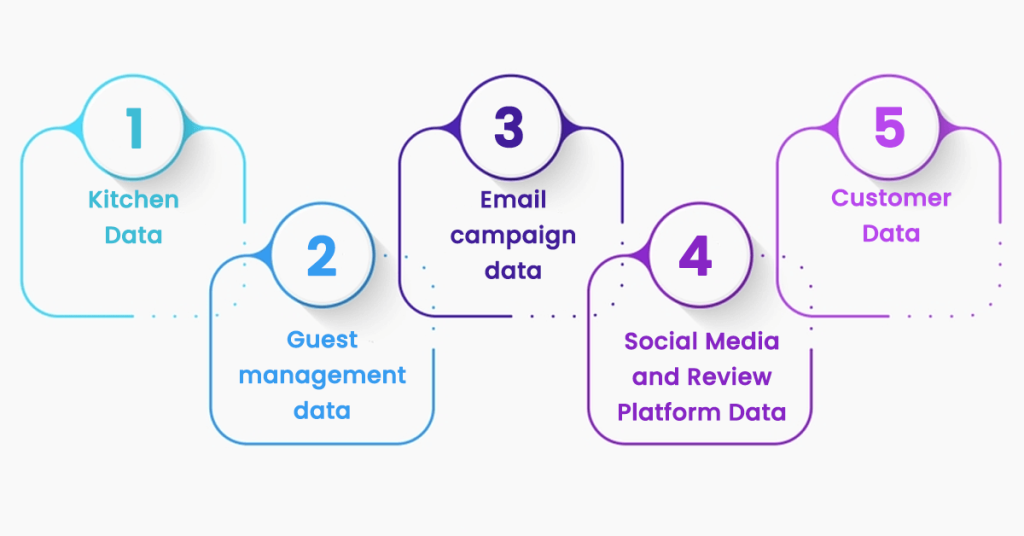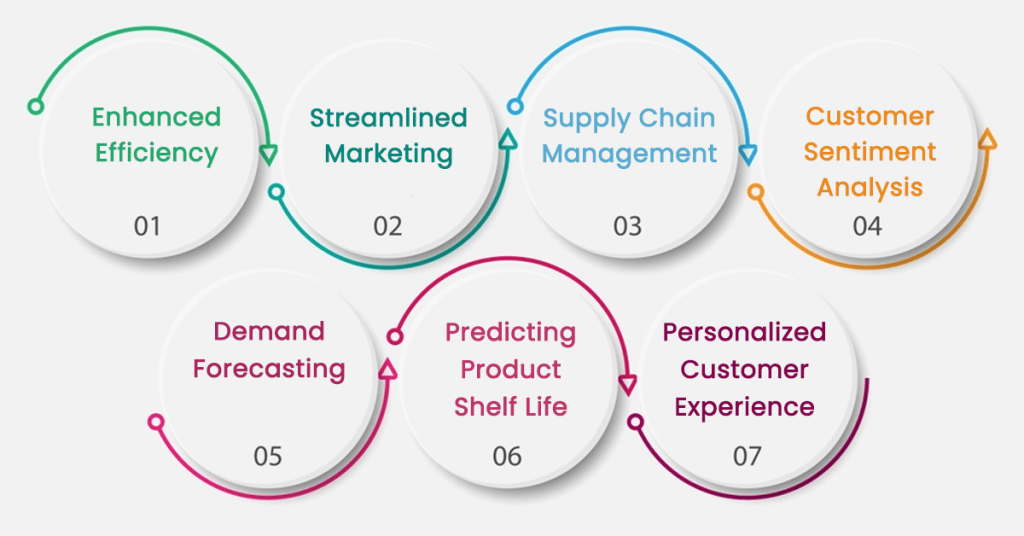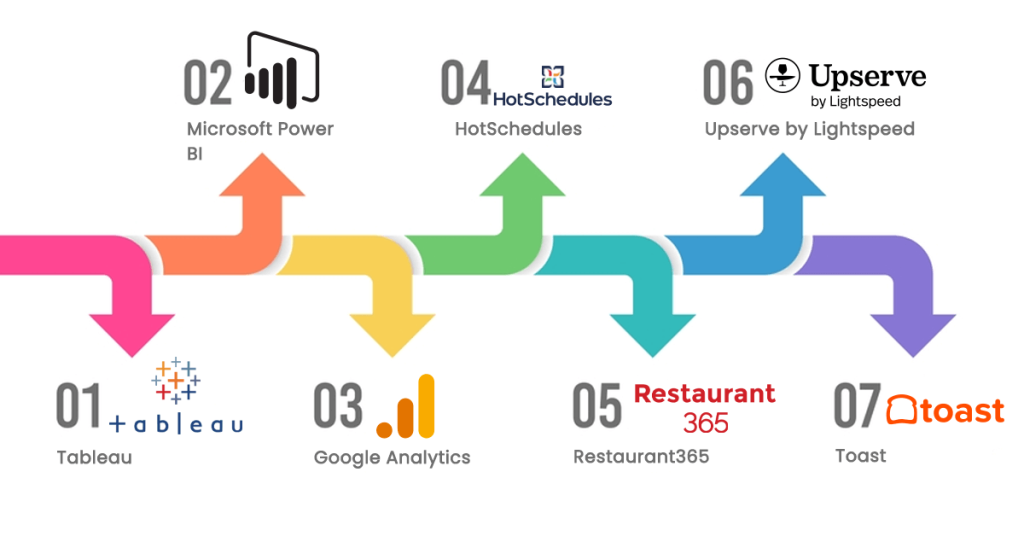Quick Summary:
Data analytics transforms the restaurant industry by optimizing operations, improving customer experiences, and increasing profitability. Key benefits include enhanced efficiency, personalized experiences, streamlined marketing, and improved supply chain management. Tools like Tableau, Power BI, and Google Analytics help analyze data for better decision-making, ensuring restaurants stay competitive and meet evolving customer demands.
Introduction
Information is precious in organizations today because it assists them in evaluating their performances and improving on them if necessary. With data, the company can then understand what has gone well and what requires an overhaul. For restaurants, this means using data to discover what customers like to eat, when they are busiest, and their efficiency. Data analytics in restaurant information is helpful because it educates restaurants and allows them to make the right choices for their business. For example, changing a menu or enhancing service delivery to customers can fetch better results.
The market size of big data analytics was estimated at USD 307.51B in 2023. The overall market size is forecasted to expand from USD 348.21B in 2024 to USD 924.39B by 2032, indicating a CAGR of around 13% during the predicted period. Utilizing data analytics for small restaurants and large restaurant chains prefers expert restaurant data analytics companies to thoroughly plan and integrate enhanced models that assist in boosting customer base and increasing revenue. In this blog, we will describe all the tools used for restaurant analytics and how your restaurant can benefit from this data. This will also share insights on how you can make your business perform better and increase the amount of customers.
What is Restaurant Analysis?
Restaurant analytics is a form of data analysis that involves collecting, analyzing, and interpreting data to transform data insights into informed decision-making. On the other hand, restaurant reporting evaluates the datasets, but restaurant analytics thoroughly analyzes the data and finds the root cause behind it.
Restaurant data analytics is helpful for single restaurants and restaurant chains and franchises in multiple locations. It provides streamlined data analysis within a single interface by integrating data from various restaurants based on locations. This saves time and unnecessary costs of compiling data for a comprehensive understanding. With this analysis, restaurant owners can understand the various factors that make a restaurant profitable, such as sales, business operations, inventory management, menu listing, and prices, and offer enhanced training opportunities to employees.
Unable to make informed decision with large amount of raw restaurant data?
Types of Restaurant Data

Big data analytics is shifting paradigms in the restaurant industry since users receive different information about how a restaurant is operated and new information regarding consumers.
1. Kitchen Data
The kitchen data is considered an essential aspect of ensuring the smooth operations of restaurants. This data enables restaurant owners to make data-driven decisions and reduce expenses. Data analytics in restaurants also assist in optimizing customer experience by managing kitchen hygiene and inventory.
2. Guest management data
Leveraging extensive data of guests based on crucial metrics assists in the strategic decision-making process. This enhanced understanding provided by guest management platforms helps restaurant owners manage customers effectively. This includes tracking wait times, order sizes, table turnover rates, and capacity at different times and other days. By analyzing this information, they can improve efficiency and enhance the overall customer experience.
3. Email campaign data
Email campaigns are crucial for many businesses, and data analysis can make them more effective. With a customer data platform (CDP), restaurants can track how many people open their emails, how many click on links, and how often their emails successfully reach inboxes. Large datasets from restaurants can determine the duration and particular time customers visit the most. Automated email campaigns make this data more effective, increasing engagement and returns on investment. This could be the magic that unlocks the door to more customer attraction and retention.
4. Social Media and Review Platform Data
Through the results obtained from social media and the review site, restaurants can identify the popularity of their brand and its coverage. They can also track the performance of each post using customer engagement and learn the public’s opinion via the reviews.
With this information, restaurants can post material that will reach customers at the perfect time when they are online.
5. Customer Data
Restaurants can be heavily dependent on customer data, which assists in fostering strong relations with customers and collecting valuable data insights from them. The data is collected to maintain separate profiles of the visitors. This can include names, email addresses, phone numbers, zip codes, dates such as birthdays, first visit dates, favorites orders, and purchase frequency.
Benefits of Using Restaurant Analytics
Restaurant data analytics is transforming the experience of the customers. These enhanced analytics allow customers to make informed decisions and help restaurant owners to attract new customers. Here are the benefits of restaurant analytics in the evolving industry :
1. Quality Control
Big data assists with necessary data insights into the supply chain cycle of the food industry. Like for example, food items that are sensitive to fluctuations in the temperature including milk, vegetables, and fruits. These are required to be monitored strictly under various environmental conditions to prevent them from spoiling. Utilizing IoT-enabled sensors, it becomes easy to get real-time product data to be shipped. It also suggests product quality and eliminates low-quality products with restaurant inventory management software.
2. Smooth Food Delivery
In this competitive era, most restaurants offer multiple options for food delivery services. By utilizing data analytics, restaurants can easily manage delivery by collecting data on routes and customer preferences. This data helps drivers to deliver orders on time.
3. Franchise data
Customer management apps assist franchise owners in monitoring the habits of customers from multiple locations. With cloud-based apps and restaurant revenue management platforms, data from different sources can be easily collected to make the brand more profitable.
4. Personalized customer experience
Online restaurant apps have high-tech features to streamline workflows and ensure constant user experience. They also help owners with customer analytics so that restaurants can efficiently meet customer needs and boost customer satisfaction.
5. Optimize restaurant flow
Modern data collection sensors implemented in the restaurant helps in keep the track of how easily customers find things by their own. This assist restaurant owners to enhance the internal layout of the restaurant.
6. Segmentation of Customers
By segmenting the customers based on specific characteristics, restaurants can be easily gather necessary data to ensure targetted messaging. Data like location, marital status, age, and gender assist restaurants and franchises to evaluate effective approaches for a smooth marketing process.
7. Feedback
The most highlighting benefit of the restaurant analytics is offering effective feedback for the dining experience. To collect feedback, inquiry forms, feedback forms, and reviews on social media. This assist restaurant owners in analyzing the service feedback and making improvements if required by using restaurant menu optimization techniques.
Want digital data management for your restaurant business?
How Restaurant Analytics helps in Modifying the Industry
Restaurant analytics softwares reveal the optimization of various aspects of the restaurant business, including performance indicators, marketing strategies, customer satisfaction, and work organization plans.

So, how does predictive analytics work? Predictive analytics works by leveraging authentic data, measurable calculations, and machine learning strategies to assess future results. Here’s an outline of key concepts and processes:
1. Enhanced Efficiency
AI and ML technologies assist restaurants in becoming more efficient with refined data analytics tools. It means that these tools can enhance the search for the most suitable suppliers. This includes explicitly vendors for inventory, clarifying the supply chain, and looking for opportunities. With this, they can easily optimize costs without any decrease in quality. For instance, most reservation and booking systems relieve the staff to concentrate more on improving customer relations. Restaurant data analytics solutions uses AI tools to take orders by ensuring decreased order error, and the gadgets suggest dishes according to the customers’ tastes.
2. Streamlined Marketing
Marketing is crucial to attracting and retaining customers. Data analytics assists restaurants in understanding needs and creating a means of communicating with them in detail through the establishment’s social media platforms. Thus, data insights by integrating restaurant marketing analytics can be applied to presenting special offers, temporary discounts, and individual recommendations based on previous purchases.
3. Supply Chain Management
Price transparency of the elements used in prepared food is becoming increasingly critical, especially for vegan people. Data analytics can also manage supply chains and inventory, making it easy to avoid instances of delay or shortage. This is crucial for all restaurants that contain both local and imported consumables.
4. Customer Sentiment Analysis
Customer experience implies analyzing customer sentiments based on their use of restaurant services, such as likes on social media platforms, online bookings, eating at the restaurant, and comments. It also assists restaurants in noting customer experiences and what needs to be improved or done, pointedly from the customer’s view.
5. Demand Forecasting
Forecasting assists chefs in planning timely meals that are in line with customers’ demands. Therefore, if pasta is usually ordered in the evening, it should be prepared during that time. It assists in planning the emergence of daily operations, modification of meal preparation as well as conservation of food.
6. Predicting Product Shelf Life
Data analytics help in the precise calculation of the shelf life of foods, as well as give guidelines that can be followed by consumers to avoid health complications. This is especially important in handling foods and any other product with a short shelf life, as well as avoiding legal suits.
7. Personalized Customer Experience
Consumers have also become more demanding from the organisations. In this respect, data analytics assist restaurants in satisfying these expectations by analyzing customers’ details like orders, payments, and feedback. It also serves the master purpose of improving and sustaining the level of customer loyalty and satisfaction.
Restaurant Analytics Tools and Technologies

Analytical tools and technologies help restaurants operate more efficiently, make data-driven decisions, and provide better customer experiences. For instance, tools are available to tell the preferred customer options, how many food portions to order, and the most appropriate time to employ the workforce. Let’s evaluate the popular restaurant data analytics software and tools:
1. Tableau
Tableau is a restaurant business intelligence tool that takes raw data and converts it to a format that can be analyzed and interacted with visually. Businesses can also use it to study consumption patterns, customer characteristics, and business efficiency within restaurants. The analysis is based on the program, which has a very convenient and easy-to-use drag-and-drop functionality, which is essential for users who do not have much experience with data analysis.
2. Microsoft Power BI
In simple language, Power BI is a business analytics service that allows the creation of reports and uses them as efficient tools for visual presentations. It can pull data from social media and restaurant customer feedback from POS systems. It helps monitor Key Performance Indicators, including sales performance, customer satisfaction, and inventory control.
3. Google Analytics
The main area of the Google Analytics application is investigating websites and online presence. Restaurants can monitor all visitors to the site, the behavior of their guests on the site, and the efficiency of Internet banners. It gives an indication of the demographics of the customers, the most visited pages, and the conversion ratios.
4. HotSchedules
HotSchedules operates specifically in workforce management. Labor management assistance is also another critical way through which it assists restaurants in minimizing the costs since it offers the restaurant huge information on scheduling factors, labor dispensation, and compliance with the labor legislation. It also helps in controlling the overworking of some staff and also makes sure there is adequate staffing during busy hours.
5. Restaurant365
Restaurant365 is a cloud-based multichannel management solution that handles restaurant accounting, inventory, and scheduling. However, the POS system gives a complete analysis of the financial position, food costs, and various aspects of labor management. This assists in efficient cost evaluation, which can help find ways to cut expenses and, therefore, increase
6. Upserve by Lightspeed
Upserve has a portfolio with features such as POS, payment processing, and analytics available. It helps in the analysis of sales, consumption patterns of the people, and efficiency of the employees as well. For instance, it can determine leading products in a store, customers’ spending patterns, or server throughput.profitability.
7. Toast
Toast is a restaurant management system that covers POS, online ordering, and many management features for employees by integrating restaurant staffing optimization. It also provides analytics features that can be used to track sales and inventory and analyze consumers. Managers can use this data to decide which foods should be put on the menu during staffing and to improve the efficiency of service delivery.
Advancements in the Restaurant Industry

The restaurant industry is constantly evolving with advancements in the latest technology. These technologies assist in enhancing service offerings and staying competitive with market upgrades. Most restaurants shift to advanced management solutions from traditional ones. This helps in achieving digital excellence by blending technological tools in the restaurant.
1. QR Code
In a mobile-centric market, customers want to manage everything with a few taps on their smartphones. According to the analysis, the downloads of QR codes have increased by 750% in two years. QR codes are one appealing aspect that helps restaurants digitize menus, reservations, payments, feedback, and tours to enhance ambiance. This assists in improving customer engagement and satisfaction to ensure repeat visits and boost loyalty.
2. Contactless payments
Due to the pandemic, various industries have increasingly utilized contactless payments. This trend has not been untapped in the restaurant industry. Customers can pay seamlessly by using any payment mode from online links, QR codes, net banking, tap and pay, or other touchless devices.
3. High tech Kitchen Management
Modern technology has transformed the way restaurants manage orders, inventory, restaurant and staff performance, menus, service quality, and many other aspects. POS (point of sale) platforms seamlessly blend with online kitchens to boost various aspects. These include order taking, streamlining the sequence of orders, order transfer to chefs, delivery speed, and specific requests by using restaurant menu analytics procedures.
4. Online Reservation
Booking a table based on preferred time, date, table setup, and location is taking a boost in this digital world. Most people prefer to make restaurant bookings online to avoid waiting time and ensure enhanced convenience.
5. Cloud Kitchens
Cloud kitchens are a new but growing trend in the restaurant industry. With advanced restaurant customer insights software, it has elevated the global drive-thru and takeaway market. Customers can order online, and the restaurant, operating from a cloud kitchen with no dine-in area, prepares the food. A delivery person then brings the food to the customer. The whole process is made efficient with the help of advanced technologies like AI and ML. Food delivery apps manage diverse cloud kitchens, allowing them to prepare and deliver meals quickly.
Conclusion
Thus, data analytics in the restaurant industry is a perfect tool to improve almost all aspects of large and small restaurants. Data collection is a valuable method for restaurants to get insights into different aspects of their business, be it sales or demographics of the clients, among other things. For example, the sales data could show the appropriate time for a restaurant to be busiest or which meals are ordered most frequently so that a restaurant can adjust the types of meals it offers and the number of workers accordingly. Therefore, with the knowledge of these trends, small restaurants can make the right decisions when choosing issues such as menu amendments, motivational offers, and inventory. X-Byte Analytics is the leading analytics consultant for restaurants that evaluates restaurant performance metrics. Restaurant data analytics companies like X-Byte operational efficiency, customer insights, menu optimization, inventory management, and staffing optimization.






